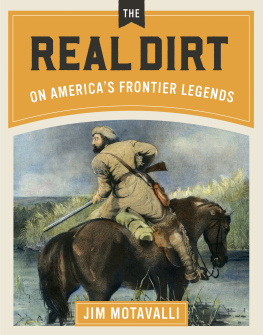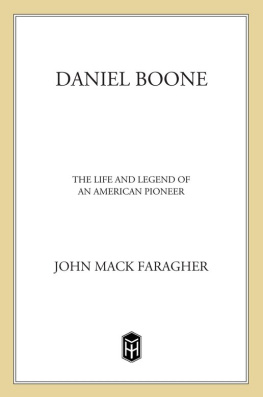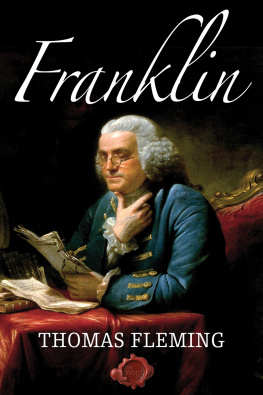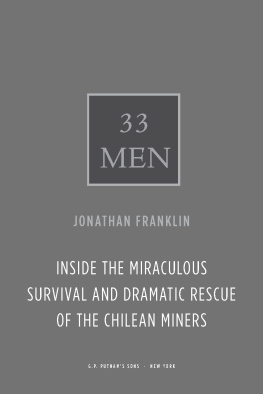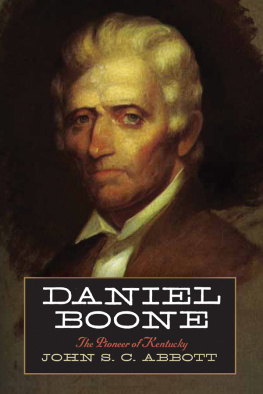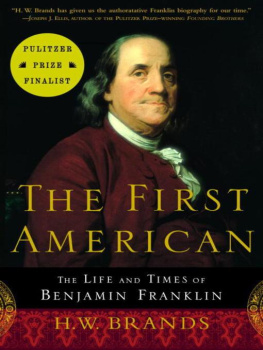Published by The History Press
Charleston, SC
www.historypress.com
Copyright 2020 by Ted Franklin Belue
All rights reserved
Cover: Chester Harding (American, 17921866); Portrait of Daniel Boone (17341820), 1820; Oil on Canvas. Gift of Mr. and Mrs. Arthur H. Almstedt. Conservation funded by the Honorable Order of the Kentucky Colonels, 2015, 1957.7. Collection of the Speed Art Museum, Louisville, Kentucky.
First published 2020
E-Book edition 2020
ISBN 978.1.4396.7132.0
Library of Congress Control Number: 2020938498
Print Edition ISBN 978.1.4671.4588.6
Notice: The information in this book is true and complete to the best of our knowledge. It is offered without guarantee on the part of the author or The History Press. The author and The History Press disclaim all liability in connection with the use of this book.
All rights reserved. No part of this book may be reproduced or transmitted in any form whatsoever without prior written permission from the publisher except in the case of brief quotations embodied in critical articles and reviews.
Also by Ted Franklin Belue
The Long Hunt: Death of the Buffalo East of the Mississippi
The Hunters of Kentucky: A Narrative History of Americas First Far West, 17501792
Edited
Peter Houstons A Sketch in the Life and Character of Daniel Boone
Lyman C. Drapers The Life of Daniel Boone
This book is for
Lavina Turbeville Belue
When he moved from that country that he left every promise to himself that he never would return to Kentucky again owing to Some mistreatment he had Received therein consequence of that promise I objected to his Remains being Removed to Kentucky.
James Boone to Lyman C. Draper, October 11, 1855
My father and mother were sadly out of fix when they thought he had been so badly treated about his land titles to come and dig his old bones up after Picking out the Place for his wife and telling them all to lay him by her side. Carrying them to Kentuckylaying some Old Stumps around their graves.
Eviza Coshow to Lyman C. Draper, March 1, 1883
Boone was soured against Kentucky.If Boones bones could but speak the real feelings the old man cherished in his lifetime, they would have protested indignantly against their removal to Kentucky.
General Edward Coles to Lyman Draper, circa 1850s.
Daniel Boone requested his body should not rest in Kentucky. He never got over the feeling that Kentucky had treated him unjustly.
Mrs. A.K. Weir, circa 1880s
PREFACE
Daniel Boone died September 26, 1820, near Marthasville, Missouri. He was interred beside his wife, Rebecca, who had died seven years earlier, on a grassy rise above Tuque Creek in David Bryans family cemetery. Twenty-five years later three Kentuckians representing the Frankfort Cemetery Company returned to the Bluegrass on a steamer named Daniel Boone, bearing their remains. Amid much pomp and ceremony, and attended by a crowd nearly twenty thousand strong, the famous frontier couple was reinterred in the capitals new garden cemetery.
Despite rumbling thunderheads, drizzling rain and a damp slog up Frankforts Main Street the procession that Saturday went remarkably well. Reinterring the Boones was the citys ultimate groundbreaking ceremony to herald its fancy necropoliss grand opening, the singular event coinciding with the FCCs newspaper advertisements to sell burial plots.
Many years later, Missourians charged that the commonwealth had retrieved Rebecca but not Daniel, claiming that the FCC had reburied an unknown enslaved person of African descent, sparking a long simmering debate: Where is Daniel Boone buried?
FEW ATTEMPTS AT UNTANGLING the enigmatic fate of Boones bones are as quixotic as the one told to me by a late-night caller who, with his wife, had driven to Frankfort to sit by Boones tomb and chant invocations to summon Dan and Rebecca from eternitys abyss. (One hopes it was a low-attendance day and that the cemetery superintendent was elsewhere.) After waving sacred crystals overhead they dropped a plumb bob on a thread, inviting the Boones to stir. Presently, Daniel hearkened and signaled back, the enigmatic voice in my receiver said, by causing the bob to sway. Nothing was heard from Rebecca.
Likewise in Missouri, a psychic was summoned to Boones Tuque Creek grave. Hunting for some trace of Danno one was sure what the medium was looking for; she never said and puzzled onlookers were too polite to askshe shuffled among the weathered gray stones and towering walnut, hackberry, persimmon and cedar, her divining rods bobbing and sidewinding. After a few laps of the cemetery she frowned, stared at nothing for a while and left, leaving her L-shaped brass rods in a bystanders hands.
In 1856 when the austere bibliophile Lyman C. Draper, the State Historical Society of Wisconsins corresponding secretary, interviewed Nathan Boone and his wife, Olive, in Missouri, there is no hint that the reburial rumor about Nathans father was mentioned. Today that is the one question a Boone speaker can depend on getting. Neutrality on Colonel Boones whereabouts is not an option on either side of the Mississippi, as I learned.
Booked for a speaking engagement one night at a venue deep in the Bluegrass that shall remain nameless, I strode to the podium and launched into my Boone talk, rambling through Colonel Dans forays and ending with his last Missouri sunset and legacy. Afterward were questions, including, of course, the dreaded warhorse: Where is Daniel Boone buried?
I gave my pat response: The documents say so and so; Kentuckians argue this and that; Missourians claim that and this; historians argue the matter.
My articulate dodge had never failed me. Except this time.
As the crowd filed out, a tall, elderly man in a black suit walked toward me with resolution, his darkly patinaed cane poking ahead and gold watch chain dangling from a silk-lined vest pocket. He fixed me in his sights, elevating his hickory parallel to my nose. Peering past its rubber toe I took him to be in his eighties as he began our row with, Sir, the Daughters of the American Revolution put that monument up in Frankfort. My dear departed mother was part of that outfit. We all know Daniel Boone is under it.
In truth, the DARs founding came thirty years after Boones tomb was built. No matter, he was armed and ready to throw down over his mothers good name, which I had unknowingly besmirched. I mumbled something like, Yes, sir, likely, youre right. Glaring but honor satisfied, the old Kentuckian lowered his cane, donned his fedora with a dignified flourish and left, tap-tapping off in the night like Captain Ahab.
I packed with haste and fled to the safety of Motel 6.
HOW DID THIS BEGIN? Was there any truth to it? Why did it matter where Daniel Boone was buried? What elements sustained these tales as they mutated from racist lore into canonical decrees in history books? Why were folks so protective of Boones body parts, even his memory?
There was more to this tale than a hunt for a mans bones. I would begin where Daniels biographies endon his death bed. Working forward, Id juxtapose his vanished realm with what it became in my day. This was not hard to do east of the Mississippi where many of his trails are marked; a few, like U.S. Highway 25-E, which began as Boones Wilderness Trail, are highways.


